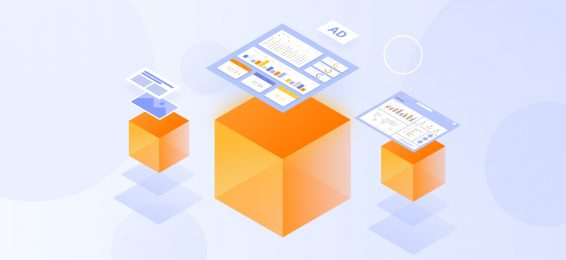As the complexity of software development in AdTech increases, it puts more burden on the hiring process. The average interview time for hiring senior software engineers is 40.8 days.
Hiring AdTech software engineers can take even longer due to the need for extensive domain knowledge, and the growing importance of AI/ML competency in this industry.
In order to reap the benefits of your AdTech software team – faster time to market and increased collaboration across teams and departments – it’s important to understand the industry context in which you operate and which software development specialists will be best suited to it.
The modern job market offers a vast range of software engineers with wide-ranging expertise. Besides specialization in programming language or technologies, there is division by so-called generalists, I-shapers, and T-shapers. We are going to talk about who the latter two are, which specialists are best fitted for an AdTech development project, and illustrate the way we at Xenoss approach managing and growing T-shaped engineers.
I-shaped vs T-shaped tech specialists
I-shaped specialists are narrowly specialized professionals, such as designers, software developers, or data engineers. I-shapers get proficient in a particular stack of technology and then only polish this specific expertise.
Hiring I-shaped software development specialists can be a good fit for certain long-established, conservative industries, such as healthcare or financial services.
These companies have in-house expertise for any set of problems and value deep proficiency in a particular discipline instead of tech outlook and knowledge in the related domains. For instance, a QA engineer is responsible for the testing, but can’t put in the larger product context and won’t be able to perform even the minor tweaks in code or the platform UI. When I-shapers encounter more multidisciplinary tasks, they refer you to a specialist in a different department.

This is especially true if the company’s workflow is built on by RUP (Rational Unified Process) methodology that entails completing one stage of development, clearly recording it in the documentation, before moving on to the next. The first release “in production” often occurs after a few months. This works if the external conditions are relatively constant.
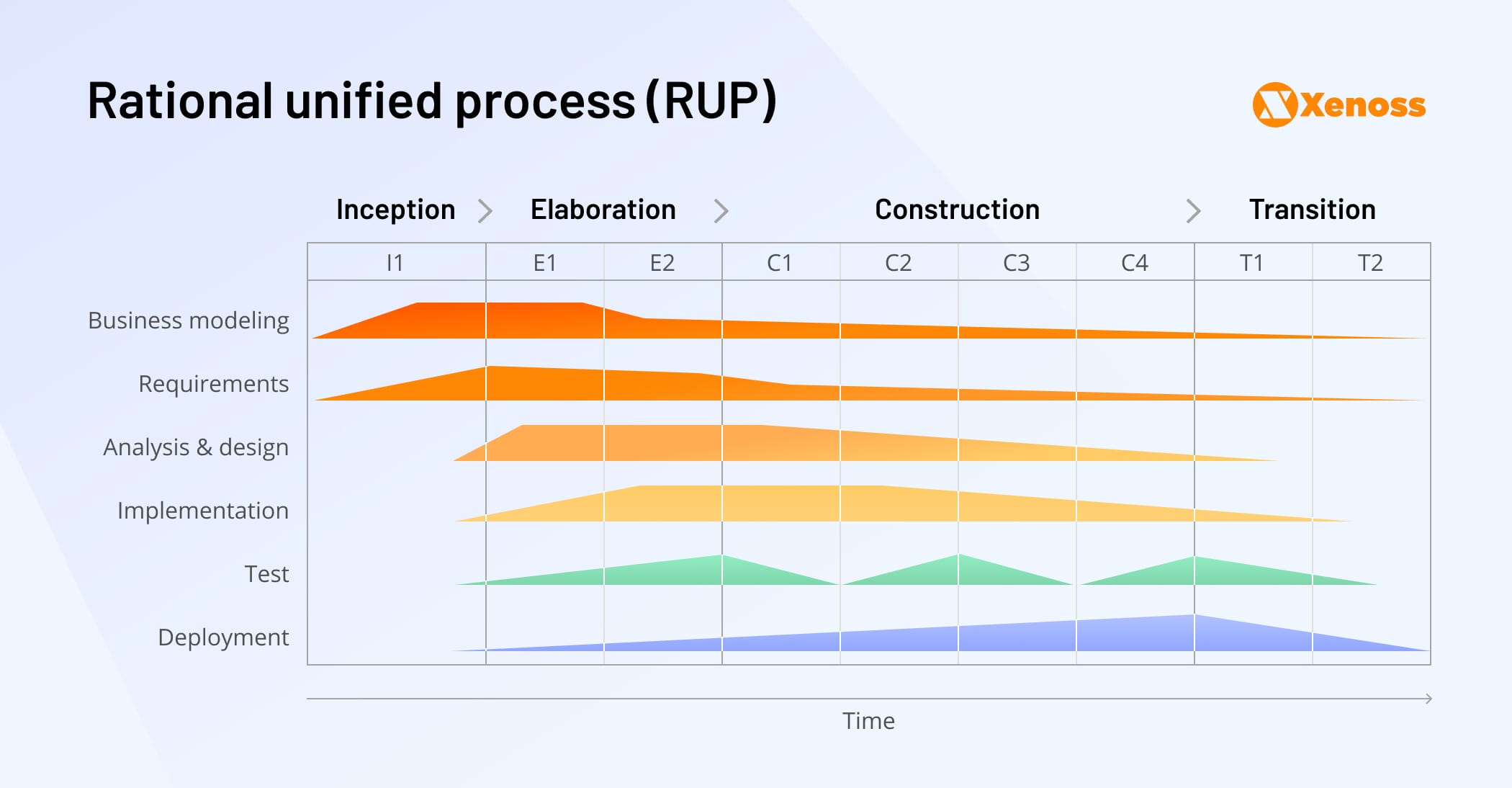
But if the product exists in the industry with a high degree of uncertainty and fast-paced market changes, such as in AdTech, a different development approach is needed. It is vital to focus on feedback from the market rather than focusing on the canonical rules for building development processes.
To avoid downtime and increase the speed of delivery, AdTech software development seeks out T-shaped specialists. These are people who have their own deeply studied specialization (similar to the I-shaped) and competencies in related areas.
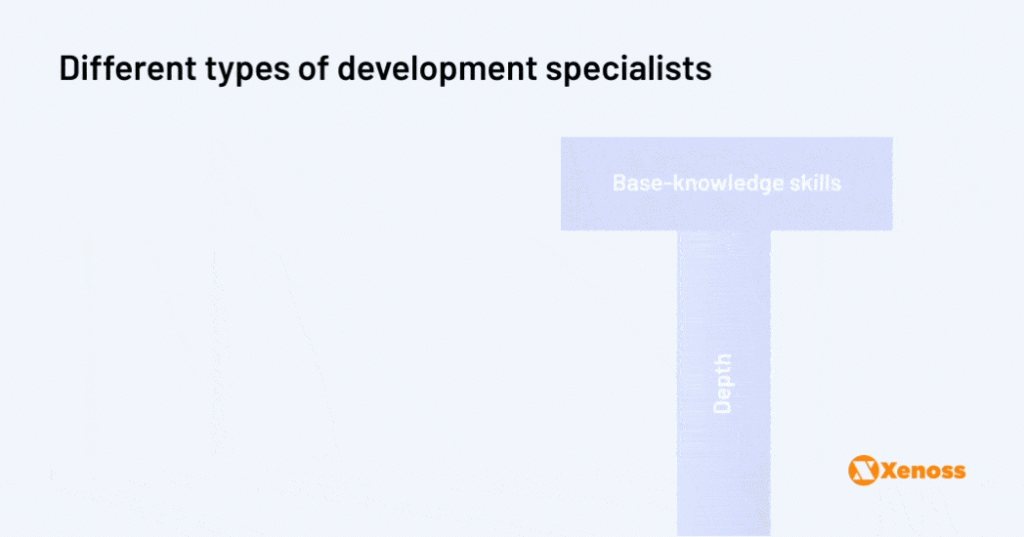
The concept of T-shaped skills is a metaphor that has been used in recruiting since the 90s of the last century. The concept can be represented as two stripes: horizontal and vertical.
- The horizontal bar (Breadth of Knowledge / General Skills) is the ability to interact with experts in other fields and apply their knowledge in areas other than one’s own.
- The vertical bar (I-Shaped / Expert in one thing) is a deep competence in a particular area.

In this scenario, a QA knows everything required to do the job, but also understands UX design, can create unit tests, can perform basic DevOps operations, etc.
In sophisticated AdTech projects, very often there is a critical lack of horizontal stripe width. Understanding and knowledge in related fields help to find a “common language” in the team, speed up the creation of a product, and improve its quality.
A T-shaper, while having a specialized skillset, also understands the product development holistically (different engineering environments, tools, and specifications). This gives the client an enormous advantage: keeping the team small and consequently cost-efficient, the team approaches the development the right way from the beginning.
Vova Kyrychenko, CTO at Xenoss
Challenges of AdTech dev team composition and management
AdTech development teams work in a rapidly shifting market, with changing user preferences, and tough competition, on comprehensive business tasks that have various ways to approach them. AdTech companies need engineers with knowledge in adjacent disciplines and the ability to adapt and synthesize expertise.
For instance, to increase conversion rates for a media buying platform (a classical business objective for AdTech projects), data engineers have to take into account lots of factors from the related domains: The competitive landscape, AdOps specifics, potential hardware issues, the platform’s business use cases.
To determine whether T-shapers are the right fit for AdTech projects, let’s talk first about the typical team composition and management challenges.
Hiring for a technically demanding project
Assembling the dream team for a complicated and technically demanding project, common for the AdTech market, is a challenge in itself. Hiring narrowly-specialized senior tech talent might put a significant burden on the project due to the steep cost and long time to hire. The scale of necessary expertise might turn out to be smaller, and you’ll overspend on expensive work hours.
Instead of hiring people with a narrow skillset, AdTech companies need to prioritize tech specialists with wide knowledge that can approach the problem holistically.
Igor Petrenko, Solution Architect at Xenoss, emphasizes the importance of extensive tech and product knowledge for the optimal development of the AdTech software:
It’s not just about mastering tools and platforms. In every project, our tech team gains an in-depth understanding of the underlying technologies: the tech stack, internal components, operating systems, and hardware. By diving so deep and optimizing the product’s core, the solutions we build parallel-process hundreds of thousands of requests and are ready to support the next milestones of the clients’ businesses.
The complexity of the team structure
Development in companies that rely on I-shaped specialists is predicated on the multiple managers that can merge the expertise of engineers with widely different stacks. To effectively manage the workload, project leads (or team leads/tech leads/managers) have to be familiar with the technical aspect of each specialization and be able to plan for the long haul. The typical structure for such a team can look like this:
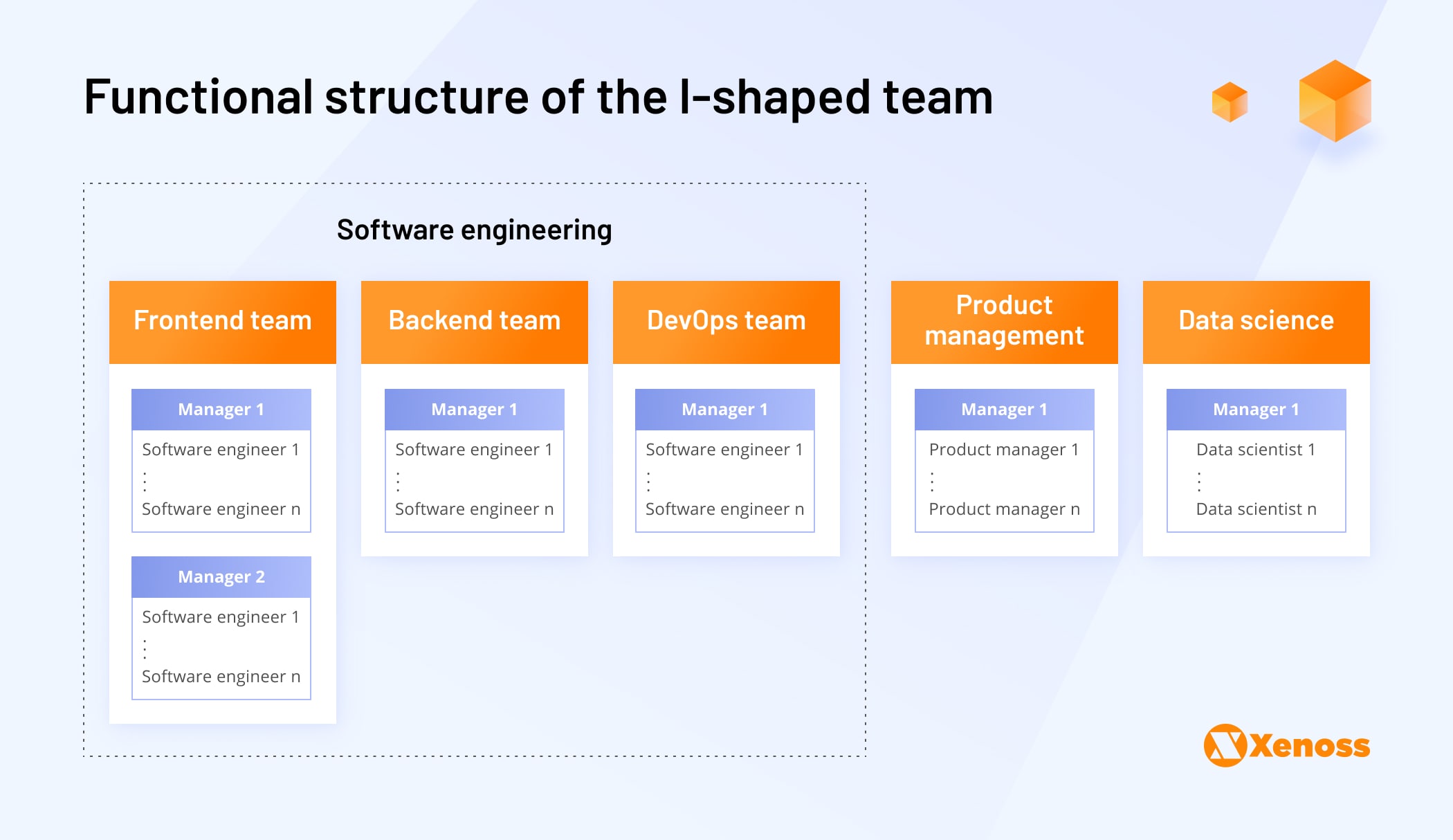
However, in AdTech software development, especially if it is an emerging product or startup, maintaining such a rigid organizational structure is often unsustainable and costly.
Budget constraints for new roles
Besides paying for multiple managerial roles, you might face the need to increase the budget on the go, each time you require some narrow expertise. For example, a few DevOps tasks emerge during the project span. You had no budget allocated for an additional position, but I-shaped back-end engineers cannot substitute for its functions so you’ll have to extend the project’s budget anyway. On the other hand, small teams of senior T-shaped developers, that have more universal tech expertise from the beginning, are more cost-effective in the long run.
Understanding the business environment
Managing business objectives of an evolving AdTech product requires actionable tactical solutions and long term planning – a combination that requires a profound understanding of the domain.
The software engineer in this industry needs a thorough understanding of the competitor landscape, privacy regulations, supply chain logic, the typical data, and identity challenges. Even the most skilled I-shaper won’t be able to navigate these treacherous waters. AdTech engineers need a corresponding knowledge of AdOps, data science, and data architecture to comprehend the complexity of the technical solutions they have to devise.
Communication in cross-functional teams
Establishing a common language for a team of I-shaped specialists can be challenging. It is incredibly difficult to establish a clear feedback loop between developer, architect, tester, and data scientist. Narrow specialists don’t understand each other well, their vocabularies vary, and they tend to focus on their own well of knowledge. Workflows are not symmetric; with small volumes, it is difficult to plan the work of a deep specialist without allowing downtime.
Why T-shaped expertise is indispensable for AdTech software development
We recommend prioritizing T-shaped specialists in the hiring process since only these specialists are well-equipped for the multidisciplinary nature of AdTech.
A squad of T-shapers offers you a great deal of flexibility – with feature and task prioritization, change management based on user feedback, data-driven experimentation, and even resource optimization. Such small, agile teams have already taken over the world little by little, even banks and insurance providers.
A T-shaper is appreciated for several qualities:
- Outlook. In a modern, competitive business, this property is one of the most valuable. Knowledge of related or distant subjects helps create nonstandard solutions and solutions “at the junctions.”
- Universality. A T-shaper can reinforce the development of any part of the project at any stage, providing close to 100% utilization of his working time.
- Interoperability. It saves the manager’s time on establishing workflow and communications, which helps avoid misunderstandings that result in the waste of the development resource.
- Agility. Such a specialist is a walking backup for some team members. What if a Python developer gets hit by a coronavirus? A T-shaper will be able to pick up the dropped baton and continue the project.
Due to the complexity of AdTech software projects, knowledge of the domain and technology outlook is absolutely critical to solving the business challenges of this industry.
T-shapers are capable of solving the challenges of our complex niche that requires brainstorming with a multi-disciplinary team, experiments, and improvisation for the optimal solution. The team of T-shapers can also help you keep the software development expenses in check; they can optimize when specialized development would just write off the costs.
[cta-no-description title=”Looking for T-shape experts for your AdTech team? ” url=”https://xenoss.io/dedicated-development-teams” buttontext=”Get in touch”]
Xenoss success case: a T-shaped team for an AdTech platform
To put into perspective how T-shaped experts reinforce the development of AdTech projects, let’s review a real-world case from our practice.
One AdTech solution Xenoss delivered is a customer data platform for mobile apps. Due to the initial focus on T-shaped expertise in the hiring process, we were able to assemble a multifaceted team that could adapt to the changing needs of stakeholders.
In the projects, we agree on the quarterly business objectives with the client that are ambitious, and usually concern optimization of specific processes or increasing performance KPIs. Those are tasks typical for startups that operate with a high degree of uncertainty. If the team didn’t understand the project holistically, we wouldn’t able to anticipate the software’s future problems and possible outcomes that allow us to develop optimal solutions.
To deliver a solution with utmost efficiency, team members require a comprehensive understanding of the business objective and understand different aspects of its implementation:
Business/AdOps. How do the projects align with the business processes and market landscape
Engineering. Software development, the technical underpinning
Data science. AI models and machine learning algorithms, the core of the solution
Product and Delivery. DevOps, automation, and development infrastructure
For instance, data scientists on this project need basic AdOps knowledge. Otherwise, they won’t distinguish different inventory types for optimization and won’t build realistic models. Effective communication between team members would also be impossible without some understanding of the domain.
Before beginning the quarter, the entire team discusses the business objective and decides on the best strategy to approach it. It is much easier for our team of T-shaped professionals to convey ideas and formulate a shared product vision. In the I-shaped team, the company would have to invest more management resources to make those wheels turn.
The project crew holds several sessions where each team member lays out their vision for the project. Then we summarize those outputs in the roadmap. The T-shaped team can quickly reach a consensus and proceed with the development due to the holistic understanding of the project by the entire team.
Important notice about a T-shaped engineering team
Having T-shapers on your team is not a silver bullet against all development constraints. Despite their broad expertise, you cannot expect them to perform exceptionally well in every domain.
Product managers frequently expect T-shaped engineers to be full-fledged tech consultants in everything. A T-shaper can adjust and get up to speed with various tech stacks. Yet they still have a main area of expertise.
Expecting an engineer to be an expert in data architecture, cloud technologies, and UI design is simply not realistic. Developers can substitute for each other when there is a need and assume different roles throughout the project while acknowledging the strong and weak sides of each team member is essential. You can’t put a generalist in charge of an infrastructure decision that requires years of expertise and a solid track record.
Developing T-shaped expertise within your company is also a separate organizational challenge. Working in a cross-functional team can sometimes mean expanding expertise in the corresponding domains is more cumbersome than in a functionally aligned organization. Introducing “guilds,” a.k.a communities of practice, can facilitate this process, as they do it in Spotify.
How Xenoss grows T-shaped specialists
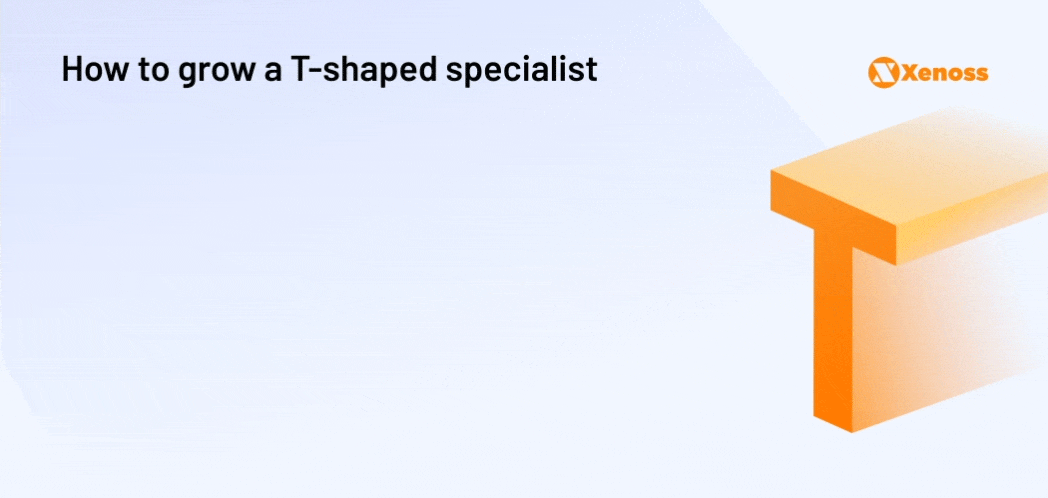
While you can sometimes find skilled T-shaped engineers on the market, that’s not always the case. You can approach this problem by growing such specialists internally. To develop a T-shaped specialist within your ranks, you must create the right environment and conditions for them.
Autonomy. Everyone must understand their responsibility for what they do. The individual or team must be able to make their own decisions. In turn, management must provide room for potential mistakes while having clear guidance and streamlined control processes in place that eliminate mistakes in the client-facing solution.
Motivational goal. Each team member must understand the overall goal and be aware of what their contribution brings to the table. Instead of a straightforward task, they should be responsible for solving a business challenge with the creative freedom to choose the technical and tactical approach.
Space for growth. Something this allows people to show their best qualities, learn something new, and be the best at something. And this is the main prerequisite for nurturing the T-shaped – setting problem-oriented tasks, allocating time for research, and mastering a new skill set to create solutions.
Our development methodology at Xenoss fully supports these three objectives. The team strategizes with the client for the optimal solution to a given business challenge, collectively sets goals and tactics to achieve them, and bears the responsibility for successful execution. The work is divided into sprints, and for each, a goal or goals are set that brings the team one step closer to achieving the final result.
To make this collaborative process work, Xenoss AdTech software engineers pick up the knowledge and skills from the related disciplines and establish effective cross-functional communication to foster a holistic understanding of the project. This stimulates the search for ideas to improve the product.
Takeaways
A T-shaper, capable of picking up knowledge on the fly and establishing proficiency in the related disciplines, is the most valuable asset for the AdTech project, especially with a diverse tech stack. Modern advertising technologies are developing in the direction of syncretism, dense intersection, and even partial mergers of various domains.
The team of I-shapers can be a good fit for the company with a rigid managerial structure and a long-term incremental delivery process. For time-sensitive AdTech software development with a high degree of uncertainty, especially for an emerging product, you need a T-shaper to analyze the problem on several levels and work out a solution.
T-shaped specialists are especially valuable for emerging AdTech products, where they quite often have to work in startup mode, adapt to the constantly changing context, and at the same time be able to demonstrate team effectiveness and deliver real business value.
